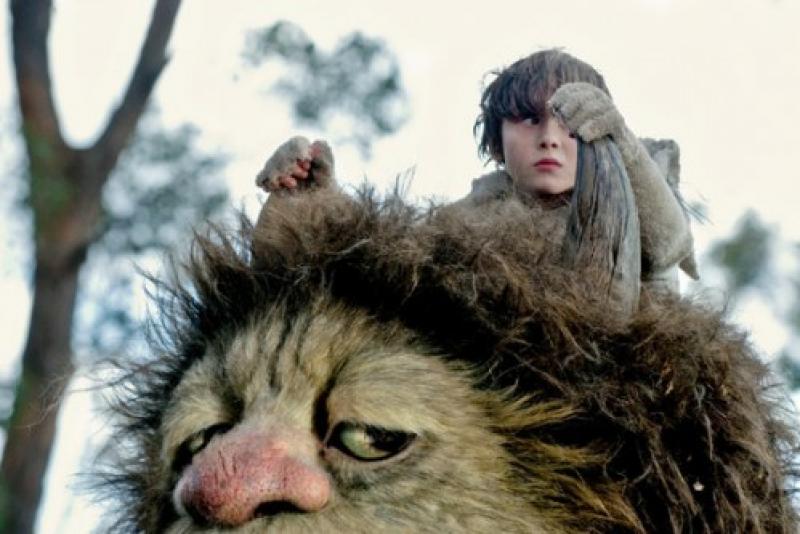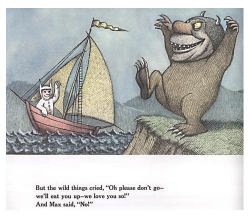Where the Wild Things Are | reviews, news & interviews
Where the Wild Things Are
Where the Wild Things Are
Spike Jonze walks on the wild side

Beware the ids of kids: Where the Wild Things Are, Spike Jonze's film of Maurice Sendak's seminal children's picture book, centres on a hyperactive nine-year-old boy, Max (Max Records), who’s so angered and frustrated by the reverses of a winter's day that he destroys a keepsake he gave his adolescent sister and ends up biting his single mother (Catherine Keener) while she’s entertaining her boyfriend at home.
This first and best section of the movie sets up Max’s voyage that night to a faraway land occupied by a handful of huge two-footed beasts who speak in urban Americanese, are apparently middle-aged neurotics, and wreck and throw things as eagerly as Max, whom they soon name king.
 Sendak’s slim, resonant book, published in 1963, makes it clear that Max’s adventure is a dream by having a forest grow in his room after he’s sent to bed for angrily telling his mom he would eat her up; from there, he sets sail and disembarks on the Wild Things’ country or island. Perhaps to distance the story from the dream structure, Jonze and screenwriter Dave Eggers first send the tyke, dressed in his wolf suit, running uncontrollably onto the street and into a wood where he finds the shore and the boat, but the film depicts a dream no less. It’s accordingly over-determined.
Sendak’s slim, resonant book, published in 1963, makes it clear that Max’s adventure is a dream by having a forest grow in his room after he’s sent to bed for angrily telling his mom he would eat her up; from there, he sets sail and disembarks on the Wild Things’ country or island. Perhaps to distance the story from the dream structure, Jonze and screenwriter Dave Eggers first send the tyke, dressed in his wolf suit, running uncontrollably onto the street and into a wood where he finds the shore and the boat, but the film depicts a dream no less. It’s accordingly over-determined.
The seven Wild Things variously manifest or give voice to different emotions that Max experiences during the frantic first 15 minutes, not only rage, but sadness, loneliness, and a feeling of betrayal. Aspects of Max’s physical reaiity are also echoed during his adventure: in the prologue, Max builds an igloo that’s crushed (with him in it) by one of his sister’s friends; later he sees the Wild Things smashing their huge huts and visits a model mountainscape they’ve built - before and after one of them, Carol (voice by James Gandolfini), destroys it offscreen. Meanwhile, a snowball fight Max instigates at home is echoed by the Wild Things’ clod fight.
Both the most evolved and regressive of the Wild Things - which were created through costumes, puppetry and CGI - Carol is the one with whom Max identifies. He carries with him a sense of loss, not only for his faded friendship with the gentle, philosophical KW (voice Lauren Ambrose) but for the closeness of the group that enabled them to build the model - Max obviously misses the father he only sees at weekends and the togetherness of his family. Carol has repressed his anger to the point of instability, and the moment when he takes it out on the giant bird Douglas (voice Chris Cooper) is shocking: it leads to the film’s funniest (and blackest) sight gag.
As Max’s sojourn with the Wild Things wears on he begins to tire of their company and gaze longingly over the sea to where Mom is. We may find ourselves tiring of them, too. Where the Wild Things Are is an ambitious film and commendable for its original handling of a complex subject, but it suffers from the lugubriousness of its anthropomorphic dysfunctional family, seemingly modelled by Sendak on his own relatives. As well as Carol, there is the kvetching warthog-like Judith (voice Catherine O’Hara) and the perceptive but downtrodden goat Alexander (voice Paul Dano). They enjoy themselves when they are smashing their huts, ripping hunks out of trees, and sleeping in a big furry pile, but not one of them is inspirational, which makes the film a tough sell for children.
Still, they should get along with Max, who balances his tantrums with joy and mischief. He is one of the most psychologically accurate portraits of a child in American cinema for years, and Records makes him authentic. By the time Max parts from the Wild Things, without an oversentimental farewell, we sense that in leaving them behind he is leaving the country of his early childhood - has discovered his superego, in fact - and is ready for the perils and traps of pre-teendom.
- Where the Wild Things Are opens on 11 December
The future of Arts Journalism
You can stop theartsdesk.com closing!
We urgently need financing to survive. Our fundraising drive has thus far raised £49,000 but we need to reach £100,000 or we will be forced to close. Please contribute here: https://gofund.me/c3f6033d
And if you can forward this information to anyone who might assist, we’d be grateful.

Subscribe to theartsdesk.com
Thank you for continuing to read our work on theartsdesk.com. For unlimited access to every article in its entirety, including our archive of more than 15,000 pieces, we're asking for £5 per month or £40 per year. We feel it's a very good deal, and hope you do too.
To take a subscription now simply click here.
And if you're looking for that extra gift for a friend or family member, why not treat them to a theartsdesk.com gift subscription?
more Film
 A House of Dynamite review - the final countdown
Kathryn Bigelow's cautionary tale sets the nuclear clock ticking again
A House of Dynamite review - the final countdown
Kathryn Bigelow's cautionary tale sets the nuclear clock ticking again
 theartsdesk Q&A: Idris Elba on playing a US President faced with a missile crisis in 'A House of Dynamite'
The star talks about Presidential decision-making when millions of lives are imperilled
theartsdesk Q&A: Idris Elba on playing a US President faced with a missile crisis in 'A House of Dynamite'
The star talks about Presidential decision-making when millions of lives are imperilled
 Urchin review - superb homeless drama
Frank Dillane gives a star-making turn in Harris Dickinson’s impressive directorial debut
Urchin review - superb homeless drama
Frank Dillane gives a star-making turn in Harris Dickinson’s impressive directorial debut
 Mr Blake at Your Service review - John Malkovich in unlikely role as an English butler
Weird comedy directed by novelist Gilles Legardinier
Mr Blake at Your Service review - John Malkovich in unlikely role as an English butler
Weird comedy directed by novelist Gilles Legardinier
 Don't Let's Go to the Dogs Tonight review - vivid adaptation of a memoir about a Rhodesian childhood
Embeth Davidtz delivers an impressive directing debut and an exceptional child star
Don't Let's Go to the Dogs Tonight review - vivid adaptation of a memoir about a Rhodesian childhood
Embeth Davidtz delivers an impressive directing debut and an exceptional child star
 One Battle After Another review - Paul Thomas Anderson satirises America's culture wars
Leonardo DiCaprio, Teyana Taylor, and Sean Penn star in a rollercoasting political thriller
One Battle After Another review - Paul Thomas Anderson satirises America's culture wars
Leonardo DiCaprio, Teyana Taylor, and Sean Penn star in a rollercoasting political thriller
 Steve review - educator in crisis
Cillian Murphy excels as a troubled headmaster working with delinquent boys
Steve review - educator in crisis
Cillian Murphy excels as a troubled headmaster working with delinquent boys
 Can I get a Witness? review - time to die before you get old
Ann Marie Fleming directs Sandra Oh in dystopian fantasy that fails to ignite
Can I get a Witness? review - time to die before you get old
Ann Marie Fleming directs Sandra Oh in dystopian fantasy that fails to ignite
 Happyend review - the kids are never alright
In this futuristic blackboard jungle everything is a bit too manicured
Happyend review - the kids are never alright
In this futuristic blackboard jungle everything is a bit too manicured
 Robert Redford (1936-2025)
The star was more admired within the screen trade than by the critics
Robert Redford (1936-2025)
The star was more admired within the screen trade than by the critics

Add comment